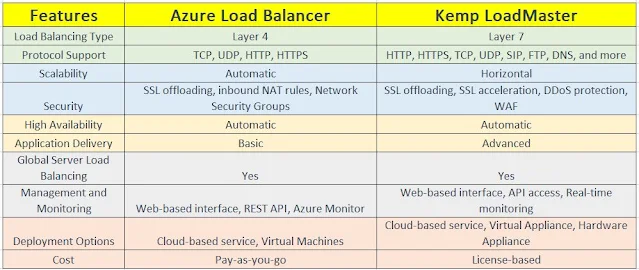Azure Load Balancer Vs Kemp LoadMaster
Load Balancers in Network
Azure Load Balancer Vs Kemp LoadMaster
Lets talk about the difference between Azure and Kemp Load Balancers. Before that we can talk about the basics of Load Balancers.
What is a Load Balancer ?
A load balancer is a hardware or software solution that distributes network traffic over numerous servers or virtual machines in order to optimize resource consumption, assure high availability, and improve application and service performance.
Load balancers function as a traffic manager or intermediate between the client and the server, accepting incoming traffic requests and directing them to one of multiple servers depending on a set of predetermined rules. Load balancers may distribute traffic depending on a variety of criteria, including round-robin, least connections, IP affinity, and application layer content.
Load balancers can boost application performance and availability by spreading traffic over numerous servers or virtual machines, preventing any one server from being overloaded or unavailable. They can also enable scalability by dynamically adding or deleting servers based on demand.
Load balancers are frequently used in online applications, e-commerce sites, and other services requiring high availability, scalability, and performance. Depending on the organization's needs, they can be deployed as physical appliances, virtual computers, or cloud-based services.
Azure Load Balancer and Kemp LoadMaster are both solutions for load balancing traffic across multiple servers or virtual machines. However, there are some differences between the two
Azure Load Balancer
Azure Load Balancer is a Microsoft Azure cloud-based load balancing solution. It distributes incoming traffic over numerous virtual machines (VMs) or servers to guarantee that applications have high availability, performance, and scalability. |
| Fig 1.1- Azure Load Balancer |
The Azure Load Balancer runs at the OSI model's Transport layer (Layer 4), allowing it to execute basic load balancing operations like as round-robin, hash-based, or IP affinity-based load balancing. It can handle both inbound and outgoing traffic and supports a variety of protocols including TCP, UDP, and HTTP/HTTPS.
- Azure Load Balancer distributes traffic across multiple VMs or servers, ensuring that applications are highly available and resilient to failures.
- Azure Load Balancer can scale up or down based on the demand for applications, providing flexibility and cost efficiency.
- Azure Load Balancer provides security features such as SSL offloading, inbound NAT rules, and network security groups to secure applications and data.
- Azure Load Balancer monitors the health of VMs or servers and can automatically route traffic to healthy instances, ensuring optimal application performance.
- Azure Load Balancer can be integrated with other Azure services such as Virtual Network, Traffic Manager, and Application Gateway to provide a complete load balancing and application delivery solution.
- Azure Load Balancer offers a range of management and monitoring features, including a web-based interface, REST API, and Azure Monitor.
Kemp LoadMaster
 |
| Fig 1.2- KEMP LoadMaster |
- Kemp LoadMaster ensures high availability and reliability of applications by distributing traffic across multiple servers and ensuring that traffic is rerouted in case of a server failure.
- LoadMaster can scale horizontally by adding more servers to the pool of available resources.
- LoadMaster provides SSL offloading, SSL acceleration, and advanced security features such as DDoS protection and WAF (Web Application Firewall) capabilities.
- LoadMaster can distribute traffic across multiple data centers or regions, ensuring optimal performance and availability for global applications.
- LoadMaster can optimize application delivery by prioritizing traffic, compressing data, and caching content.
- LoadMaster offers a range of management and monitoring features, including a web-based interface, API access, and real-time monitoring of server health and performance.
 |
| Fig 1.3- Azure LB Vs KEMP LoadMaster |
Continue Reading...
++++++++++++++++++++++++++++++++++++++++++++++++++++++++++++++++
VMware : NSX-T Load Balancer Vs AVI Load Balancer - The Network DNA
VMware NSX-T Load Balancer, Virtual Server, Pool & Monitor Components
VMware NSX Advanced Load Balancer - The Network DNA
NSX-T Load balancer Deployment Topology - The Network DNA
F5 Load Balancer : Upgrade the SSL Certificate - The Network DNA
22 Basic F5 Load Balancer interview questions - The Network DNA
Load balancers are important part of the Network ? - The Network DNA
++++++++++++++++++++++++++++++++++++++++++++++++++++++++++++++++







